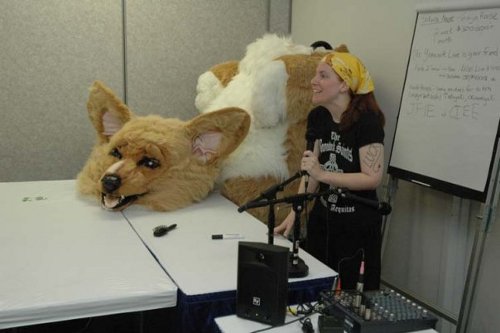Meet and follow up on the other group and individual cosplayers who have come before you

While watching the series finale and after having read the post by Amy Schley (linked earlier in this post), who was in the skit with the 11 female Doctor Whos that won a prize over three of the “heroes,” I thought back to how I first heard about cosplay as it related to anime conventions.
Back in the 1990s, the first anime-only conventions started to appear all across North America and where you had anime, you also had costuming. And where you had costuming, you also had masquerade contests.
At first, as was described by Schley and depicted for much of the “Heroes of Cosplay” series, the costume contests were casual affairs where they announced your name and the name of the character you were costumed as, you walked across a stage, did a few poses, and then walked off again. Gradually, people started competing in groups, writing skits and sketches to perform on stage, building props and small set pieces to go with the costumes. Then, came the lip synching, choreographed dance moves, and then when audiences complained that they couldn’t hear the cosplayers on stage, skits were choreographed to pre-recorded dialog.
By 2003, it wasn’t uncommon to see an entire group of people cosplaying as characters from the same movie or TV series, lip-synching and dancing to filk songs as seen here in this masquerade act from San Diego Comic Con 2003:
Sadly, this group of costumers disbanded after a few years and some of them aren’t involved in the scene anymore. The same could also be said for some of the members of this group of cosplayers from a slew of different classic anime series who won Best in Class: Journeyman and Best in Show at Katsucon in Arlington, Virginia a year later:
And that’s what’s bothering most of the people who complain about “Heroes of Cosplay.” Where in any of these episodes is cosplaying depicted as being something that’s fun to do with friends both old and new? Sure, there are many who want to turn their penchant for crafting and prop making into a career and yes, there are many who have done so like Tristen Citrine (aka Charlene Ingram) who went from working as a costumer for the character program of the Venetian resort in Las Vegas and selling cosplay wigs and accessories online to becoming the senior brand manager for FUNimation Entertainment and later, the senior manager of animation marketing at Viz Media.
There’s also Nickey Froberg Drayer, a cosplayer I met and became friends with during Anime Expo 2001. She started going to conventions and cosplaying in the Midwest and the East Coast and was infamous for her foam and fur recreations of beloved anime mascot characters like Panda Genma from Ranma ½, Pen Pen from Neon Genesis Evangelion, and Ein from Cowboy Bebop. It was this last piece which earned a prominent place in the portfolio which lead to her landing a job at WETA Workshop in New Zealand.
Before she passed away this year on October 30, Drayer had actually watched an episode or two of Heroes of Cosplay, and her husband George told me that when they talked about the show, “[Nickey was quick to point out that the cosplay scene she was a part of was a community, not the catty competitive environment the series shows.” That’s also very much the impressions I’ve gotten from the many cosplayers I’ve been privileged to know over the years, each of whom have fascinating and interesting stories to tell about their lives both before and after they ever picked up a needle or a hot glue gun to work on their first costume.
But it wouldn’t be too difficult to integrate these smaller stories into the stories about the featured “Heroes.” Han and Ingram once judged the Craftsmanship awards together at the now defunct Ani-Magic convention in Lancaster, California in 2001; why not do a segment where they get together again to catch up and discuss making cosplay out of characters for Viz Media’s newest anime series? There were tons of people who showed up to Jessica Merizan and Holly Conrad’s costume party that was featured in the penultimate episode, including anime voice director and actor Taliesin Jaffe. I’m sure that any one of them has an interesting story to tell about how they got into costuming and how far they want to go with it.
Because as the late Nickey Drayer said, costuming is fun. And as much as the SyFy network doesn’t want to admit it, there’s way much more to the art and craft than competition.
So that would be my final decree and production note: Bring a more human element to the series by showing how being an amateur costumer has changed peoples’ lives.
My attorney is standing by to field any inquiries.